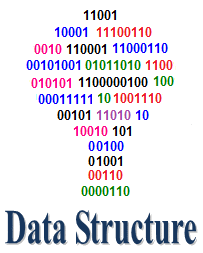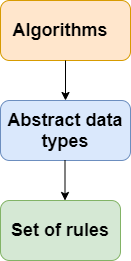TheDeveloperBlog.com
C-Sharp | Java | Python | Swift | GO | WPF | Ruby | Scala | F# | JavaScript | SQL | PHP | Angular | HTML
Data Structures | DS Tutorial
Data Structures | DS Tutorial with Introduction, Asymptotic Analysis, Array, Pointer, Structure, Singly Linked List, Doubly Linked List, Circular Linked List, Binary Search, Linear Search, Sorting, Bucket Sort, Comb Sort, Shell Sort, Heap Sort, Merge Sort, Selection Sort, Counting Sort, Stack, Qene, Circular Quene, Graph, Tree, B Tree, B+ Tree, Avl Tree etc.
Data Structures Tutorial
Data Structures (DS) tutorial provides basic and advanced concepts of Data Structure. Our Data Structure tutorial is designed for beginners and professionals. Data Structure is a way to store and organize data so that it can be used efficiently. Our Data Structure tutorial includes all topics of Data Structure such as Array, Pointer, Structure, Linked List, Stack, Queue, Graph, Searching, Sorting, Programs, etc. What is Data Structure?The data structure name indicates itself that organizing the data in memory. There are many ways of organizing the data in the memory as we have already seen one of the data structures, i.e., array in C language. Array is a collection of memory elements in which data is stored sequentially, i.e., one after another. In other words, we can say that array stores the elements in a continuous manner. This organization of data is done with the help of an array of data structures. There are also other ways to organize the data in memory. Let's see the different types of data structures. The data structure is not any programming language like C, C++, java, etc. It is a set of algorithms that we can use in any programming language to structure the data in the memory. To structure the data in memory, 'n' number of algorithms were proposed, and all these algorithms are known as Abstract data types. These abstract data types are the set of rules. 
Types of Data StructuresThere are two types of data structures:
Primitive Data structure The primitive data structures are primitive data types. The int, char, float, double, and pointer are the primitive data structures that can hold a single value. Non-Primitive Data structure The non-primitive data structure is divided into two types:
Linear Data Structure The arrangement of data in a sequential manner is known as a linear data structure. The data structures used for this purpose are Arrays, Linked list, Stacks, and Queues. In these data structures, one element is connected to only one another element in a linear form. When one element is connected to the 'n' number of elements known as a non-linear data structure. The best example is trees and graphs. In this case, the elements are arranged in a random manner. We will discuss the above data structures in brief in the coming topics. Now, we will see the common operations that we can perform on these data structures. Data structures can also be classified as:
Major OperationsThe major or the common operations that can be performed on the data structures are:
Which Data Structure?A data structure is a way of organizing the data so that it can be used efficiently. Here, we have used the word efficiently, which in terms of both the space and time. For example, a stack is an ADT (Abstract data type) which uses either arrays or linked list data structure for the implementation. Therefore, we conclude that we require some data structure to implement a particular ADT. An ADT tells what is to be done and data structure tells how it is to be done. In other words, we can say that ADT gives us the blueprint while data structure provides the implementation part. Now the question arises: how can one get to know which data structure to be used for a particular ADT?. As the different data structures can be implemented in a particular ADT, but the different implementations are compared for time and space. For example, the Stack ADT can be implemented by both Arrays and linked list. Suppose the array is providing time efficiency while the linked list is providing space efficiency, so the one which is the best suited for the current user's requirements will be selected. Advantages of Data structuresThe following are the advantages of a data structure:
Data Structures Index
DS Basics DS Array DS Linked List DS Stack DS Queue DS Tree DS Graph DS Searching DS Sorting
Interview Questions Singly Linked List Programs
Doubly Linked List Programs
Circular Linked List Programs
Tree Programs
Prerequisite
Before learning Data Structure, you must have the basic knowledge of C. AudienceOur Data Structure tutorial is designed to help beginners and professionals. Problem
We assure that you will not find any problem in this Data Structure tutorial. But if there is any mistake, please post it in the contact form.
Next TopicData Structure Introduction
|
Related Links:
- Data Mining Architecture
- Data Structures | DS Tutorial
- Computer Network | Data Link Controls
- DS for symbols tables
- Data Preprocessing in Machine learning
- Data Mining Tools
- Data Mining vs Machine Learning
- What is Data Science: Tutorial, Components, Tools, Life Cycle, Applications
- DS Algorithm
- DS Asymptotic Analysis
- Data Flow in Angular 7 Forms
- Data Mining Tutorial
- Data Mining Cluster Analysis
- Data Mining vs Data Warehousing
- DS Structure
- DS Array
- DS 2D Array
- DS Quene
- Different types of Clustering Algorithm
- Data Mining vs Big Data
- Data Mining Bayesian Classification
- Data Mining World Wide Web
- Data Types in C
- Verbal Reasoning | Data Sufficiency 2
- Data Mining Techniques
- DS Introduction
- Data Structure Interview Questions (2021)
- Verbal Reasoning | Data Sufficiency 1
- Top 25 Data Science Interview Questions (2021)
- Data Warehouse Tutorial
- Data Flow in MapReduce
- DS Stack
- Data Abstraction in C++
- Top 25 Data Warehouse Interview Questions (2021)
- Data Link layer
- Data Security Considerations
- DS Pointer


